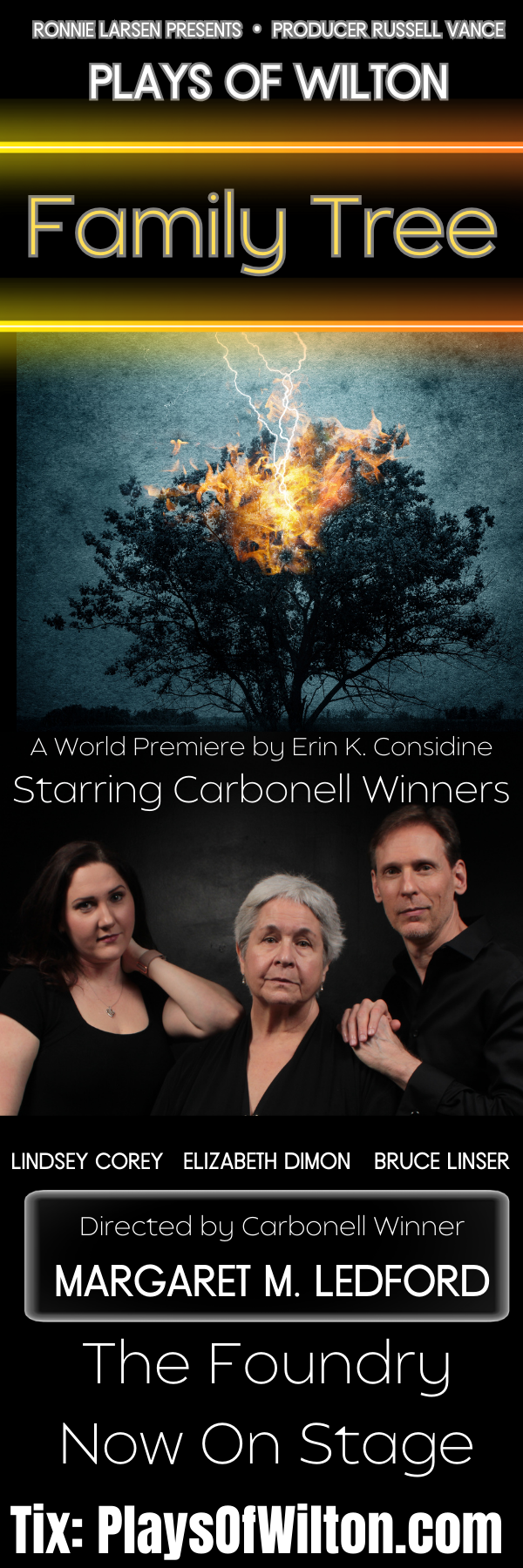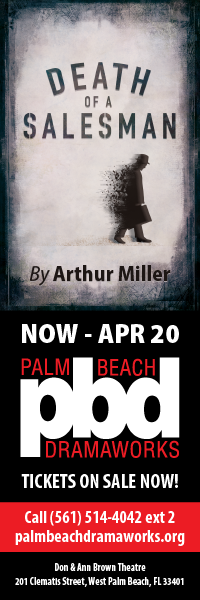
Clay Cartland, Patti Gardner, Alix Paige, Barry Tarallo and Shane Tanner as an extended family grappling with a verdiginious problem in Arts Garage’s musical The Trouble With Doug / Photos by Amy Pasquantonio..
By Bill Hirschman
Sometimes theater works even when you can’t quite explain how or why or even quite what you saw; all you recognize is that your mouth turned into a grin, your brain cells churned and you felt your throat tighten up.
Such is the quirky, thematically fuzzy but thoroughly entertaining new musical at Arts Garage, The Trouble With Doug. The titular trouble is the archetypical twentysomething hero is turning into a slug. Not a slacker. An actual slime-oozing, lettuce-addicted slug.
Certainly, messages flit under the surface of the brackish lake, barely recognizable by their murky outlines: something about learning to cope with change’s inevitability in modern life, growing up, letting go, family relationships — but no clearly defined takeaway. That can be a trifle frustrating for audiences trying to find an overarching facet to hook onto, especially in the early going of the second act.
No matter. Even if Doug is perceived by the audience simply as a rewarding evening of spoofy fun, the proceedings are boosted to a high level of quality by an A-list ensemble headed by the phenomenal Clay Cartland, smooth steady direction by Margaret M. Ledford who understands off-beat material, assured music direction by Paul Reekie, and the scruffily engaging music by Will Aronson and lyrics Daniel Maté whose incisive The Longing and The Short Of It was a surprise hit at Arts Garage last summer.
The story of a man turning into an insect, prompting varying reactions from his family, is, of course, inspired by Franz Kafka’s classic short story, The Metamorphosis, written just under a century ago. Aronson and Maté have placed it squarely in the 21st Century and invested it with a comic book/graphic novel vibe that easily mixes surrealism, science fiction, satire and seriousness. They’ve also made it quite funny.
The setting is a studiously typical extended family in Brooklyn stocked with wryly satiric archetypes who still seem relatable human beings worthy of our sympathy because of the committed performances from the cast.
Doug (Cartland) is a bright, affable 27-year-old computer executive who is about to move to San Francisco with his equally appealing fiancé Vanessa (Alix Paige). His Boomer parents, Jim (Barry Tarallo) and Lynn (Patti Gardner), are anxious about losing their “perfect” son who has been a stabilizing Mr. Fix It in the family unit. Slightly less concerned on the surface is brother Vince (Shane Tanner) who at 31 years old is still living in the basement wasting his life away.
On the eve of Doug’s departure and the day of his 27th birthday party, strange things begin to happen. First, his fingers stick to a pizza box. Then he spurts out slime. Then he develops an insatiable yen for heads of lettuce.
He tries to accept these losses of control with bemused equanimity. But much worse is yet to occur: He starts growing tiny stalks just below the line of his baseball cap, his body starts to spasm, his speech slips into guttural sounds — and then it gets really bad. He hides in the bathroom as his transformation reaches a new level hinted at by the silhouette on a scrim betraying four antenna-stalks growing out of his head and animalistic screeches of panic.
You have to love when his mother says, as is always expected in even the direst emergencies, “Whatever it is, Doug, come out. We’ll support you.” Well, maybe. His transformation at first shocks his loved ones, but then each tries to comfort and coddle him in different ways. Oddly, the most effective is Vince who evolves into a take charge guy who does his homework on the Internet. He’s the most help to Doug becoming what Doug is becoming, and the experience makes him grow up into a responsible adult.
The Trouble With Doug has an actual plot compared to Maté’s song cycle last summer for which he also wrote the music. Doug also is shot through with unspectacular but nevertheless trenchant observations about everyday relationships. They have nailed Doug and Vince’s deep affection and simultaneous envy in competitive sibling relationships as the brothers arrive in adulthood. They depict people’s tendency to see their own agenda in a blank slate as each family member interprets Doug’s incoherent animal sounds to fit their personal vision.
The script, score and lyrics have their own voice which can be wittily incisive one moment and intentionally prosaic the next, all the better to skewer modern life and foibles. But intentionally or not, the show echoes others works such as the sci-fi silliness of Little Shop of Horrors and Song of the Living Dead; as well as musical mélange of melodic and idiosyncractic that typifies Adam Guettel, Jason Robert Brown and William Finn’s scores. It’s a huge stretch to say the lyrics are in Stephen Sondheim’s league but the witty patter songs certainly seem inspired by his wordplay.
Aronson’s score is notable for some lovely ballads, but also for his atmospheric underscoring including using strings and reeds to create ominously swirling eddies of music and unearthly chattering noises like insects taking over the world. In fact, the very sound of the band (Paul Reekie on piano, Elena Alamilla on cello and Glenn Rovinelli on reeds) has a fresh chamber-orchestra feel because there is no brass, no snare drum/trap set, no obvious synthesizer filling in for an orchestra. Reekie also has done a fine job melding and guiding the five excellent singers through the music.
On the page, Maté’s lyrics are deceptively simple other than the patter songs with their internal rhymes. But married to Aronson’s music, they reveal more depth of emotion and thought than expected.
The two have been working on this project for seven years, since it first came to them as a college project. It has undergone several workshops, a complete production and was on the cusp of playing at Florida Stage when the venue closed. The result is a highly developed piece whose hard work is carefully masked.
The cast could not be bettered for acting chops and mellifluous voices. One standout – including his broad shoulders and height – is Tanner who suppresses his leading man persona in favor of the ne’er-do-well Vince. He perfectly captures a directionless loser, but then makes us believe he has found his calling when his brother needs help and he puts a gorgeous bow on the evening with the 11 o’clock solo “I’m Not Crying” in which Vince describes his affectionate but ambivalent feelings about his brother.
But once again, it’s Cartland who steals the show with his ability to be both comic and yet highly sympathetic in almost the same moment. The Doug he presents at the beginning of the evening is so normal, so admirable, so winning. But his abilities, especially as a physical comedian, get a first-class showcase. The song where his body erupts is described in the script as being “overtaken by a violent, extended, forceful, and ultimately un-transcribe-able series of fast spasms, slow elongated movements, bizarre contortions, and loud strange noises…” That’s putting it mildly. What Cartland, choreographer Marcus Davis and Ledford have created is both hilarious and horrifying. It echoes what 1950s audiences reported about Zero Mostel turning before their eyes into the title character of Ionesco’s Rhinoceros.
As funny as Cartland can be, his demeanor always contains an increasingly strong element of pathos as the metamorphosis takes over his body, his speech and his life. In one scene, he is desperately trying to retain his ability to speak by working on letters of the alphabet; his battle to enunciate the letter L is comical but deeply affecting.
Ledford once again proves herself one of the best freelance directors in the region with an ability to find and zero in on the elusive tone in off-beat material, and then unite the cast and creative team in creating a seamless single vision. A steady fluid energy propels the evening and a warm, uplifting feeling suffuses the entire production even as Doug and his family move smoothly into the dark unknown. Ledford is not a showy stager, but the proceedings never feel static even on Arts Garage’s intimate stage.
The design team under Ledford’s leadership may have a limited budget, but their imagination has no limits. James Morgan’s setting starts with what may be giant alphabet blocks scrawled in pencil by a child, augmented with blurry impressionistic skylines on projections. It’s all augmented by David Nail’s varied lighting, which often involves snap switches (orchestrated by Nail as stage manager). A special nod is due Ellis Tillman whose character-perfect costumes include an evolving series of slime green get-ups as Doug turns scene by scene into a six-foot-tall slug.
Again, something satisfying is still missing; the audience keeps reaching out with their heads and hearts for something that isn’t quite there. But that doesn’t prevent the piece from charming anyone willing to open themselves to it.
The Trouble With Doug runs through May 11 at The Theatre at Arts Garage, 180 NE First St., Delray Beach (north side of the parking garage). Performances 7:30 p.m. Wednesday-Friday, 2 p.m. Saturday and Sunday. One Saturday night 8 p.m. May 3. Running time about 2 ¼ hours including an intermission. Tickets are $30-$45. Call (561) 450-6357 or visit www.artsgarage.org







 A PaperStreet Web Design
A PaperStreet Web Design

One Response to “So A Man Turns Into A Snail…” Quirky New Musical The Trouble With Doug Is No Slug At All